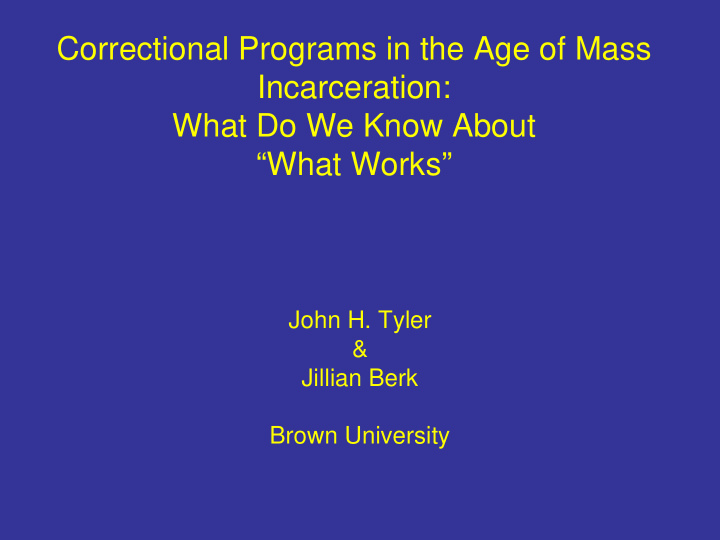



Correctional Programs in the Age of Mass Incarceration: What Do We Know About “What Works” John H. Tyler & Jillian Berk Brown University
The Age of Mass Incarceration Federal and State Prisoners in the U.S.: 1925-2000 1,400,000 1,200,000 1,000,000 800,000 600,000 400,000 200,000 0 0 10 20 30 40 50 60 70 80 1925 1935 1945 1955 1965 1975 1985 1995 2000 Source: www.census.gov/statab/hist/ HS-24 .pdf
The Age of Mass Incarceration • Current imprisonment rate: 705/100,000 …world’s leader • Corrections “industry” is a $65B per year enterprise • WHAT YOU NEED TO KNOW: Of the 2.2 million currently in jail or prison …95 percent will eventually be released
The Age of Mass Incarceration Changing Changing criminal justice economy policies Changing prison population 650,000 ex-offenders released each year.
Prison Life • Prisoners – Low education, young, minority, male, ½ serving sentences for non-violent offenses • Dominant track – Short stay, low security facility, low levels of program participation • Prison life – Staff and space shortage for bringing programs – Security is paramount – Service to facility (kitchen work, cleaning, etc.) a top priority – Substantial facility to facility movement
Programs to Impact Employment (Recidivism) • Education – Adult Basic Education (ABE) – GED preparation and testing • Vocational training • Employment – work camps – prison industry employment – work release • Post release programs (employment programs)
Evidence on Effectiveness? • As of 2000…evidence base is weak • Better research? Lessons from education? Correctional program evaluation Awakening Better research to importance methods, techniques, of rigor. and the researchers to use them. Better data.
Recent Evidence from Three Sources • Random assignment experiment – CEO evaluation in NYC • Large-scale, longitudinal survey study – National SVORI evaluation • Use of rich administrative data – Lessons from Florida
Center for Employment Opportunities Evaluation • CEO model – immediate “transitional employment” in minimum wage “neighborhood work project” jobs – assistance with job placement – post placement assistance • First year findings from random assignment evaluation – no long run employment or earnings gains – substantial recidivism effects
Serious and Violent Offender Reentry Initiative Evaluation • SVORI…a $100 million federal grant program to 69 various correctional programs over 3 years • Evaluation…five year evaluation of 69 sites and intense impact evaluation of 16 selected sites • Findings from propensity score estimates
Source:https://www.svori-evaluation.org/ Originally presented at the Justice Research and Statistics Conference, October 2007 by Pamela Lattimore, RTI
Propensity Score impact estimates Source:https://www.svori-evaluation.org/ Originally presented at the Justice Research and Statistics Conference, October 2007 by Pamela Lattimore, RTI
Serious and Violent Offender Reentry Initiative Evaluation • Take away: – Very few of the programs funded by SVORI work…or – Given low levels of receipt of “treatment,” it’s welcome news to find any positive effects
Using Rich Administrative Data to Estimate Program Impact
The Florida Example: Russell Sage Foundation funded data collection 2000-2002 Department of Department of Tyler Law Corrections & Enforcement Kling UI wage records FETPIP 1M records, everyone arrested in Florida since 1990, complete panel of: arrests convictions incarceration spells program participation UI wage records
Lessons from Florida • Using rich set of control variables, getting a “prison GED” associated with increased earnings, but only for minority offenders (Tyler and Kling 2004) • When looking at education, vocational, or employment programs… – Everything looks good in participant vs. nonparticipant comparisons…but with more sophisticated models… – Only positive earnings effects for prison industry work and work release – Only positive recidivism effects for work release • Berk (2007) work release recidivism effects only for those who committed “income generating” crimes
Lessons from Most Recent Research • Hard to turn lives around • Simple comparisons will tell us little • Null results in good studies may be result of… – “weak” implementation of good programs – delivering effective programs to the wrong offenders – programs don’t systematically impact outcomes • Employment programs (e.g., CEO) may impact recidivism, but not through increased employment or earnings…rethink the mechanisms of employment � desistance • More targeted programs? – employment programs toward offenders who commit “income generating” crimes – cognitive-behavior and drug abuse programs toward violent crime, drug use, etc.
Recommend
More recommend